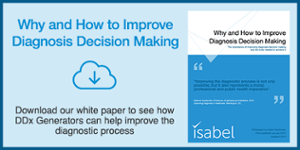- Privacy Policy
- Terms & Conditions
- Contact us
- ©Isabel Healthcare 2025
Doctors can ask for help | Mayo Clinic Study
.jpg?width=320&name=F47BW5%20(1).jpg) At the beginning of this month, Mayo Clinic published a study in the Journal of Evaluation in Clinical Practice on second opinions compared with the first diagnoses of a patient. The data was gathered from 286 patients who had been referred to Mayo internists in order to get a second opinion on their diagnosis. The publication of the study brought up some interesting thoughts and discussions on both the results themselves, and also the limitations of the study.
At the beginning of this month, Mayo Clinic published a study in the Journal of Evaluation in Clinical Practice on second opinions compared with the first diagnoses of a patient. The data was gathered from 286 patients who had been referred to Mayo internists in order to get a second opinion on their diagnosis. The publication of the study brought up some interesting thoughts and discussions on both the results themselves, and also the limitations of the study.
The results of the study
In a nutshell, the study discovered that only 12% of patients had the same diagnosis by the first doctor and the mayo internist. 66% of the diagnoses were ‘refined or better defined’ after referral, and 21% were significantly different to the initial diagnoses.
Criticism of the study
The results of this study sparked a lot of media attention, with many articles taking the positive angle of “Mayo Clinic study sheds light on value of second opinions," and many others choosing to focus on the errors of the first doctors, with titles such as “Second Opinions Reveal Extent of Diagnostic Error.” However there is one article written by Michael Joyce, MD for Health News Review which really challenged the study itself, and its limitations in truly representing the value of second opinions. Joyce talks about the small size of only 286 cases, the lack of a global and impartial representation in that all the cases were from Mayo Clinic, the author of the study, as well as the lack of context to all the cases i.e. how many doctor visits did the patient go on before seeking this second opinion? All these elements cause the data to be somewhat limited, which Dr. Mark L. Graber, President of the Society to Improve Diagnosis in Medicine agreed with, although he still thought the study was of some use: ““I agree with the problems and limitations you present. It’s important to point out that this was a very select population. But these are good data. And I’m glad we’re questioning how we’re doing in diagnosis and referrals.” There are certainly some holes in this particular study which Michael Joyce has pointed out, however, the study has still highlighted an important issue in the world of diagnosis and brought it to the forefront of public attention, which can only be good.
How differential diagnosis tools could have an impact
This study did not explicitly involve the use of digital diagnostic tools, and was simply a study to discover the efficacy of a second opinion in 283 cases. It is interesting to ask, however, how would a differential diagnosis tool like Isabel have changed these outcomes? Would the correct diagnosis have been reached in the first instance more often? Michael Joyce mentions in his article, that “Mayo didn’t follow up with these patients to find out whether their second opinion was right” and so we cannot guarantee the second diagnosis was the correct one. With Isabel being used at the second stage of the diagnosis, the referral, would we have had different results with more or less changed diagnoses? The takeaway from this is that it is potentially not only additional doctors that improve the diagnostic process and correct errors, but that technology and other tools could also help improve these scenarios.
Nothing should replace or try to outsmart a doctor
At Isabel we always support and highlight the importance of getting a second opinion when in doubt. On top of this, we also encourage the use of differential diagnosis tools, both by the patient and by the doctor, to aid in the diagnostic process. And here aid is the operative word. Doctors cannot and should not be replaced, and that includes competitiveness amongst doctors. Any good doctor can be faced with a difficult case with which they are struggling. A ‘second opinion’ or helping hand from a colleague, another institution, or a digital healthcare tool should be celebrated as an extra measure being taken to ensure the correct diagnosis can be reached. This study in a way proved that second opinions work, and this is the positive message we should be taking from it, rather than pointing the finger at who is bad and good at diagnosing. Discussion between healthcare providers, fruitful dialogues with patients, and efficient use of the tools available are the best ways to improve the diagnostic process as a whole.
Interested in how differential diagnosis tools can help improve the diagnostic process further? Download our eBook as an introduction to our ethos:

Jason Maude
Jason is the CEO and Co-founder of Isabel. Prior to co-founding Isabel, Jason spent 12 years working in finance and investment banking across Europe. His daughter, Isabel, fell seriously ill following a misdiagnosis in 1999 and this experience inspired Jason to abandon his city career and create Isabel Healthcare Ltd.
Subscribe Here!
Recent Posts
Isabel DDx Companion with ChatGPT Integration - to help you diagnose even faster
At Isabel Healthcare, we’ve always been driven by one goal: to make clinical reasoning faster,..Virtual Triage: Do more questions lead to better patient outcomes?
One of the common misconceptions related to virtual triage / symptom checker tools is that the more..List Of Categories
- Differential Diagnosis Decision Support
- Differential diagnosis
- Symptom Checker
- Symptoms
- Medical Error
- Patient Disease Information
- Disease
- Clinical Decision Support
- Diagnostic Decision Support
- Isabel 1 Minute Read
- Diagnosis Error
- Diagnosis Skills Cases
- Healthcare Informatics
- Clinical Reasoning
- Evidence-based Medicine
- Medical Education
- Patient Engagement
- Symptom Triage
- Nurse Practitioner Education
- Nursing Decision Support
- Partnership
- Public Health
- COVID-19
- EHR
- Patient Empowerment
- Patient Safety
- rare disease

Start your FREE Trial today
Try the Isabel Pro DDx generator for 30-days - no payment card details required.




